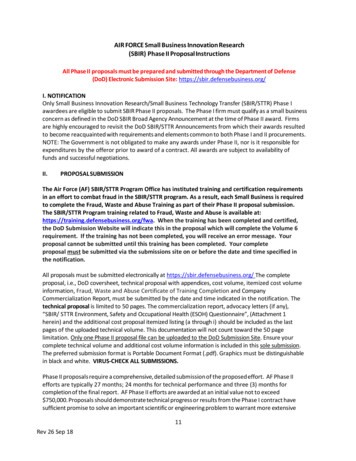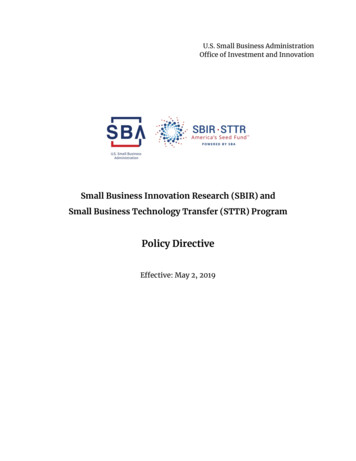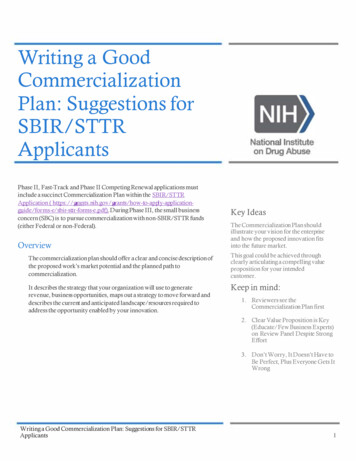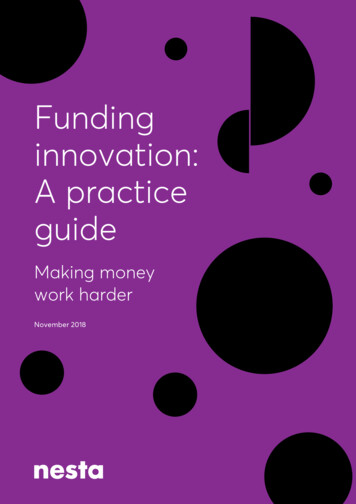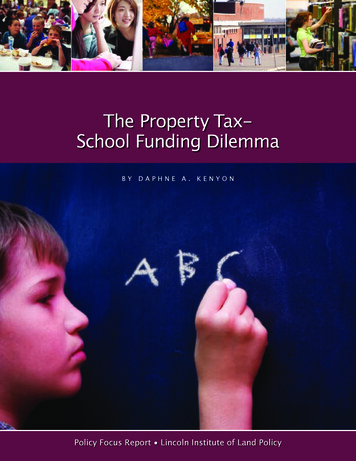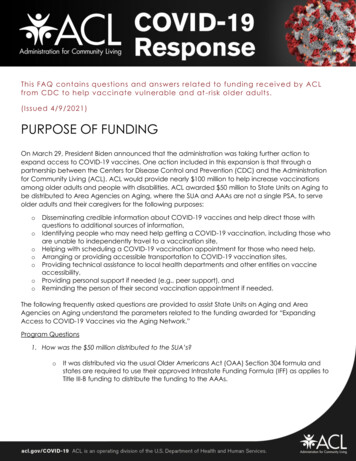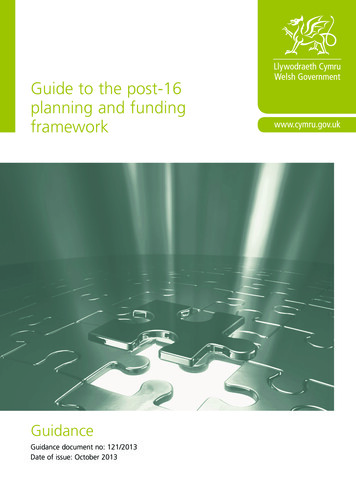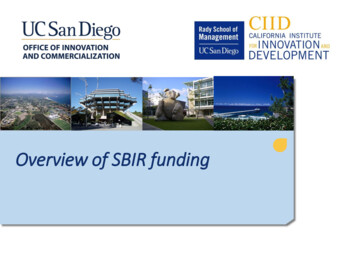
Transcription
Overview of SBIR funding
Overview Welcome New program, supporting the creation of new localcompanies, particularly those by UCSD ‘friends &family’ Introduction to SBIR funding
Follow-on Workshop As you are about to hear, SBIR applications can be complicated A workshop will be held where entrepreneurs drafting an SBIR applicationcan meet with experts Review of application sectionsReview of compliance with registration activitiesAdvice on strategy, some coaching & mentoringAt no cost to the entrepreneur We are grateful for the sponsorship of Knobbe Martens Follow up event is by invitation only. To qualify: You have an intention to form a new local small company You have started drafting an SBIR application, aiming for submission within nexttwo calls Available on the afternoon of October 24. You need to apply to attend, by emailing: cloryman@ucsd.edu
Starting a new company, and running it, can be stressful A pile of non-dilutive cash can help You don’t have to quit your day job until your application is successful UCSD is providing significant support for new entrepreneurs Expectation that some in this audience will find a funding call, andstart writing the application
SBIR/STTR History SBIR– Small Business Innovative Research– Small Business Innovation Development Act of 1982– Strengthen the role of small business concerns STTR– Small-business Technology TRansfer– Small Business Technology Transfer Act of 1992– Facilitate the transfer of technology developed byresearch institutions
Innovation Spectrum9--Phase I------Phase II------IndustryResources Available ( )------Supplements-------Investors“Valley of Death”AcademiaDiscoveryDevelopmentLevel of DevelopmentCommercialization
Characteristics of SBIR/STTR awards SBIR– Company performs 67% of work STTR– Collaboration required between university & smallbusiness– PI can be university researcher– Company performs 40-70%– University performs 30-60%
12 federal agencies administer SBIRprogramsAgencies with SBIR and STTR ProgramsDepartment of Defense (DOD)Department of Health and Human Services (HHS) including the NationalInstitutes of Health (NIH)Department of Energy (DOE), including Advanced Research Projects Agency Energy (ARPA-E)National Aeronautics and Space Administration (NASA)National Science Foundation (NSF)Budget 1.070 B 797.0MAgencies with SBIR ProgramsU.S. Department of Agriculture (USDA)Department of Homeland Security (DHS): Science and Technology Directorate(S&T) and Domestic Nuclear Detection Office (DNDO)Department of Commerce: National Oceanic and Atmospheric Administration(NOAA) and National Institute of Standards and Technology (NIST)Department of Transportation (DOT)Department of Education (ED)Environmental Protection Agency (EPA)Budget 20.3M 17.7M 206.1M 180.1M 176.0M 8.4M 7.9M 7.5M 4.2M
Contracts vs grants
SBIR and STTR – Phased Objectives Phase I– Establish the technical merit, feasibility, and commercial potentialof the project– Determine the quality of performance of the small businessorganization Phase II––––Continue the R&D efforts initiated in Phase IFunding based on Phase I results, ANDScientific and technical merit of Phase II project, ANDCommercial potential of the proposed Phase II objective Phase III– Pursue commercialization objectives
Funding periods and amountsAgency DoDAward Type (Contract, CGrant)Max. Award Amount 150KaPhase ITime of Phase INASADoTEPADoEDHSCCCGC80K150K100K95K90K6 mo9 mo6 Mo6 mo6 mo 6 mo/ 8 mo(12 moSTTR)300K 500K 450K125K150KSBIR/100KSTTR6 mo 6 mo/ (12 6 momo STTR)Award Amount Phase 1MMIITime of Phase II24 mo750K24 mo1MM 300K 1MM 750KDoC- DoCNOAA NISTCCNSFUSDA DoEDGG150K70100KG/CNIHG/C100K 150Kb6 mo6 mo300500K 1MM400K24 mo 24 mo 24 mo 24 mo 24 mo 24 mo 24 mo 24 mo 24 mo 24 mo
Phase 1 This is probably where you start! Small business applicant At least one employee, who works at least 51% forthe company Seeking to prove a concept for a solution Normally up to 150k, but can seek up to 225k Typically up to six month long project Funding is for PRODUCT DEVELOPMENT R&D SBIR is not funds to run your business! If Phase 1 is successful, you may be invited to applyfor Phase 2 funding, of up to 2M
Phase 2 Significant agency differences Fast-track submission and review of both Phase Iand Phase II grant applications Direct to phase 2 NIH, DoD, Dept. of Education ifcompleted Phase 1 milestone using non SBIR funds Phase 2a award additional financial support tophase 2 grantee associated with the initialprototype Phase 2b additional support for R&D beyond theoriginal scope NCI phase 2b bridge fund (to support the nextstage of the development) Cross programs awards and cross-agency awards(Phase 1 STTR to Phase 2 SBIR)
Finding Topics
HOW DO I FIND THE APPROPRIATE TOPIC?-Variety of SBIR/STTR topic search engines-most of agencies have search engines-grants.gov system can search across all that make awards as grants-Sbir.gov across both grants and contracts-Search with broad general topics
HOW DO I FIND THE APPROPRIATE TOPIC?- Omnibus Solicitations- Researcher-initiated ideas- Targeted Solicitations- nts- Applications may be submitted to different agencies for similar work- Awards may not be accepted from different agencies for duplicativeprojects
A made-up example Expert in electrochemistry, optical physics, and biomaterials Already filed a patent on the special chip that measurecertain compounds in the blood, and to do so non-invasively Topics biochemical sensors, and in-vivo imaging withfluorescent or magnetic nanoparticles. A post-doctoral researcher decides pure academia is not forher, and she wants to try a start-up
Is there any federal cash to support such abusiness? www.sbir.gov wearable, alcohol, biosensor Sort by relevance! Top hit is PAR-16-410 A brand new call (Aug 2016!). Which means they have cash to spend! First deadline is December 2016 (hurry!), or April 2017 The call seeks something that is non-invasive, discreet, and canmonitor alcohol levels in blood without penetrating the skin, and cangive feedback to a phone/hub. 150,000 in research funding. The scientific contact is Katherine Jung, Ph.D., National Institute onAlcohol Abuse and Alcoholism (NIAAA), Email: kathy.jung@nih.gov
Strategic PlanningBEFORE you start to write your proposal:Identify an appropriate solicitationFind one or more Institutes/Centers that are a fit for yourprojectContact the relevant Program Director(s) to validateyour assumptions** Prepare your Specific Aims page to use to facilitate this discussion
Requirements
Eligibility Company submits proposalEligibility is determined at time of award PD/PI is not required to have a Ph.D./M.D. PD/PI is required to have expertise tooversee project scientifically and technically
Do You Qualify for SBIR/STTR Award? Small Business Concern– Organized, for-profit, U.S.-based– individual proprietorship, partnership, limited liability company,corporation, joint venture, association, trust or cooperative– OwnershipAt least 51% owned by US citizens or permanent residents(precluded majority venture-backed companies)– 500 employees or fewer including affiliates PI’s primary employment ( 51%) with the smallbusiness Proposed work must occur in US– Exceptionally difficult/impossible to overcome this
Preparation: Identify the Company PI Requirement for employment by small business– At time of award– And throughout the grant period Reviewers need evidence that PI will be good fit for the project Who will guide technical activities, decisions, manage technical staff? MBA/CEO without technical credentials often receives criticism Strong proposal will overcome this Consider STTR mechanism, where academic can be co-PI
Success Rates for NIH SBIR awardsFiscalYearSBIR/STTRPhaseNumbers ofApplicationsAwarded3287121.6% 17,054,967Win RateTotal Funding2014SBIR2014SBIRPhase I362265218.0% 144,793,0792014SBIRPhase II56622940.5% 170,387,2262014STTR6058.3% 1,082,0862014STTRPhase I78816020.3% 35,828,8772014STTRPhase II873742.5% 22,182,18421.2% 391,328,4192014Fast TrackNumbers ofApplicationsReviewedFY TTR2015Fast TrackFast Track5,4511,1543376619.6% 18,157,545Phase I342551415.0% 117,110,555Phase II82324129.3% 179,946,727611016.4% 2,171,909Phase I91114916.4% 33,782,224Phase II873135.6% 21,597,18317.9% 372,766,143Fast TrackFY TOTAL5,6441,011 Resubmissions often allowed, and often higher %success than average Talking with agency personnel often helps understandcompetitiveness Especially with agencies that solicit Specific (rather thanBroad) Research topics
Application process
Timeline . 6-9 months . 245DueDateScientificReviewCouncilReviewAwardDate (earliest)April eptember 5January 5October/NovemberFebruary/March
Registration RequirementsNASA SBIRHHS SBIRNSF SBIRDOE SBIRDOD SBIRDUNSSAMXXXXXXXXXXCompany Resgistry (SBA.gov)EHB [Electronic Handbook]eRA CommonsGrants.govNSF FastLanePortfolio Analysis andManagement System (PAMS)fedconnect.netFunding Accountability andTransparency Anct Sub- awardReporting SystemDoD Submission WebsiteXXXXXXXXXXXXXX
Plan AheadDUNS number-5 minutes to complete online registrationOnce registered your DUNS number is sent by email in few daysSystems for Award Management (SAM)-Registration process can take up to 6 weeksSBA Company Registration-10 minutes to completeeRA Commons (for NIH)-Registration process can take up to 4 weeksDBA-Process takes 1-4 weeksEmployer Identification Number (EIN) from IRS-Get immediately if applying onlineLLC or incorporation- 2 days
SBIR Application Review Checklist
Writing a Competitive Proposal
Specific AimsSingle and most important page ofapplicationSets out what you intend to doAn Executive Summary of the Proposal
Tips on Specific AimsDon’t state a hypothesis that you cannottest with the experiments you are proposingAvoid descriptive phrases like: To correlate Todescribe To develop Avoid wishy-washy, passive tense, or flowerylanguageWrite aims in active form with strong meaningfulverbsNo “fishing expeditions” – microarray experiments,expression cloning, etc.
Research StrategySignificanceSignificant ScienceSignificant ProductSignificant Commercial ent33IMPACT
SignificanceDemonstrate:Significant productSignificant science/technological innovationSignificant need in the marketSignificant commercial opportunityUse references!
InvestigatorsKnowledgeableInvestigators appropriately trained and well suited to carry out thiswork?SkilledIs the work proposed appropriate to the experience level of theprincipal investigator and other researchers?Does the investigative team bring complementary andintegrated expertise to the project?
InnovationIs the project original and innovative?Does the project challenge existing paradigmsor clinical practice; address an innovativehypothesis or critical barrier to progress in thefield?Does the project develop or employ novelconcepts, approaches, methodologies, tools, ortechnologies for this area?
Quality of Approach Is there a solid hypothesis to be tested?Sound experimental design & methods Does the applicant acknowledge potential problem areas andconsider alternative tactics?
ApproachDo experiments relate to the Specific Aims?Provide an overview and conceptual frameworkAre the experiments logical and well-integrated?Why are the proposed methods the best way to go? Be surethis study is not “a technology looking for a problem”!Less detail needed for established techniquesAlternatives for high risk elements add to the feasibilityAre the end-points/milestones clearly defined?Is the appropriate statistical analysis included?Is there a sensible timeline?
ApproachPreliminary Data/Prior Workare not required for Phase I applications (but if you don’thave any, get some)should support the proposed Phase I aimsDemonstrates that the investigator has:—mastery of (and/or access to) the required techniques—ability to manage and work with collaborators/partners—sufficient attention to important details (i.e. accurate, carefullyassembled figures, tables, graphs)Reviewers will not look anything up! Providesufficient, relevant details for an informed judgment
The Great Proposal Easy for the reviewer to read, understand Interesting for the reviewer to think about Documentation of excellence in ALL of the reviewcriteria Helps the reviewer write the evaluation
The Technical ReviewerBasically volunteeringOver-committed, time-stressedProbably not expert in your specific area(but could be!)Is expert in somethingKnowledgeable in general area of panelGenerally known as smart, fair, informedWorks well in group settingThe review panel– Can influence the individuals, create a “culture”
Common Application Problems No Significance Unimportant problem, unconvincing case forcommercial potential or societal impact Lack of DETAILS Lack of 'newness’ or technical innovation Diffuse, superficial, or unfocused research plan Questionable reasoning in experimental approach Failure to consider potential pitfalls and alternatives Lack of experience with essential methodologies Unfamiliar with relevant published work Unrealistically large amount of work proposed
Budgets Direct costs Specific project costs (staff salary, consumables,outsourced services, etc) Indirect cost Rent, insurance, electric, accountancy, officesupplies etc NIH: up to 40% of direct costs in Phase I “Fee” Your company’s profit margin, usually 7% (6.99%) You can spend this on licensing fees & patent costs! Simple example: 100K direct costs, add 40,000indirect, plus 7% fee ( 9730) 149,800 total budget.(Fee is on direct plus indirect costs)
Intellectual property Summary is public information Mark confidential information as confidential– See Solicitation/Instructions on how to mark– Create statement within proposal indicating howconfidential information is marked Reviewers sign confidentiality agreements withagency File patent applications prior to submission of thegrant application “First to file”
SBIR is a great source of non-dilutive cash to help start your productfocused business! You don’t have to quit your day job until your application is successful UCSD is providing significant support for new entrepreneurs Find a funding call! Start writing the application! These slides will be available on-line, for you to use as an applicationguide.
Follow-on Workshop A workshop will be held where entrepreneurs drafting an SBIRapplication will meet with experts Review of application sectionsChecking compliance with registration activitiesAdvice on strategy, and give some coaching & mentoringAt no cost to you the entrepreneur We are grateful for the sponsorship of Knobbe Martens Follow up event is by invitation only. To qualify: You have an intention to form a new local small company You have started drafting an SBIR application, aiming for submission withinnext two calls Available on the afternoon of October 24. You need to apply to attend, by emailing: cloryman@ucsd.edu
Links nts https://www.sbir.gov/
programs Agencies with SBIR and STTR Programs Budget Department of Defense (DOD) 1.070 B Department of Health and Human Services (HHS) including the National Institutes of Health (NIH) 797.0M Department of Energy (DOE), including Advanced Research Projects Agency - Energy (ARPA-E) 206.1M National Aeronautics and Space Administration (NASA .
